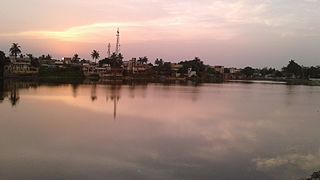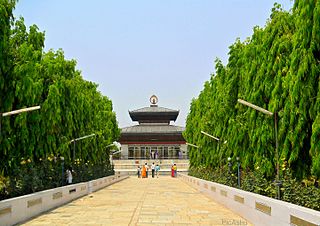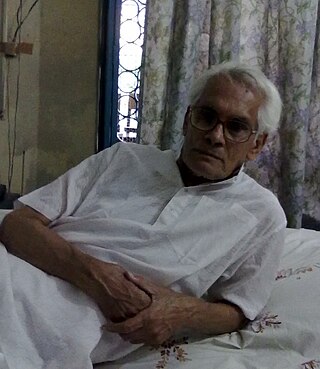
Phanishwar Nath Mandal 'Renu' was one of the most successful and influential writers of modern Hindi literature in the post-Premchand era. He is the author of Maila Anchal, which after Premchand's Godaan, is regarded as the most significant Hindi novel. Phanishwar Nath (Mandal) Renu was born on 4 March 1921 in a small village Aurahi Hingna near Simraha railway station in Bihar. The mandal community of Bihar to which Renu belonged constitutes an under-privileged social group in India. Renu's family, however, enjoyed the benefits of land, education, and social prestige. Renu's father, Shilanath Mandal, had been active in the Indian National Movement and was an extremely enlightened individual, taking a keen interest in modern ideas, culture and art.

Mahasweta Devi was an Indian writer in Bengali and an activist. Her notable literary works include Hajar Churashir Maa, Rudali, and Aranyer Adhikar. She was a leftist who worked for the rights and empowerment of the tribal people of West Bengal, Bihar, Madhya Pradesh and Chhattisgarh states of India. She was honoured with various literary awards such as the Sahitya Akademi Award, Jnanpith Award and Ramon Magsaysay Award along with India's civilian awards Padma Shri and Padma Vibhushan.
Araria is a city and a municipality that is the headquarters of Araria district in the Indian state of Bihar. Araria is situated in the northern part of Bihar.

Araria district is one of the thirty-eight districts of Bihar state, India. Araria district is a part of Purnia division. The district occupies an area of 2,830 km2 (1,090 sq mi). Araria town is the administrative headquarters of this district. Distance from Nepal border is only about 8 km from Forbesganj head quarter.
Muslim Rajputs or Musalman Rajpoots are the descendants of Rajputs in the northern regions of the Indian subcontinent who generally are followers of Islam. Reportedly, they converted from Hinduism to Islam from the medieval period onwards, creating various dynasties and states while retaining Hindu surnames such as Chauhan. Today, Muslim Rajputs can be found mostly in present-day Northern India and Pakistan. They are further divided into different clans.
The Biharis or Bihari people are a subgroup of the Indo-Aryans who speak the Bihari languages. Bihari people can be separated into three main Indo-Aryan ethnolinguistic groups, Bhojpuris, Maithils and Magadhis. They are also further divided into a variety of hereditary caste groups. In Bihar today, the Bihari identity is seen as secondary to caste/clan, linguistic and religious identity but nonetheless is a subset of the larger Indian identity. Biharis can be found throughout India, and in the neighbouring countries of Nepal, Pakistan and Bangladesh. During the Partition of India in 1947, many Bihari Muslims migrated to East Bengal. Bihari people are also well represented in the Muhajir people of Pakistan because of Partition.

Bihari Muslims are adherents of Islam who identify linguistically, culturally, and genealogically as Biharis. They are geographically native to the region comprising the Bihar state of India, although there are significantly large communities of Bihari Muslims living elsewhere in the subcontinent due to the Partition of British India in 1947, which prompted the community to migrate en masse from Bihar to the dominion of Pakistan.

Rao Bahadur and Rai Bahadur, abbreviatedR.B., was a title of honour bestowed during British rule in India to individuals for outstanding service or acts of public welfare to the Empire. From 1911, the title was accompanied by a medal called a Title Badge. Translated, Rao means "King", and Bahadur means "Brave". Bestowed mainly on Hindus, the equivalent title for Muslim and Parsi subjects was Khan Bahadur. For Sikhs it was Sardar Bahadur.
Dutta, also spelled Datta, is an Indian family name. Its variation is Dutt.

Mithila, also known as Tirhut, Tirabhukti and Mithilanchal, is a geographical and cultural region of the Indian subcontinent bounded by the Mahananda River in the east, the Ganges in the south, the Gandaki River in the west and by the foothills of the Himalayas in the north. It comprises certain parts of Bihar and Jharkhand of India and adjoining districts of the Koshi Province, Bagmati Pradesh and Madhesh Province of Nepal. The native language in Mithila is Maithili, and its speakers are referred to as Maithils.

The Noakhali riots were a series of semi-organized massacres, rapes and abductions, combined with looting and arson of Hindu properties, perpetrated by the Muslim community in the districts of Noakhali in the Chittagong Division of Bengal in October–November 1946, a year before India's independence from British rule.

Samir Roychowdhury, one of the founding fathers of the Hungry Generation, was born at Panihati, West Bengal, in a family of artists, sculptors, photographers, and musicians. His grandfather Lakshminarayan, doyen of the Sabarna Roy Choudhury clan of Uttarpara, had learned drawing and bromide-paper photography from John Lockwood Kipling, father of Rudyard Kipling, who was Curator at the Lahore Museum, and thereafter established the first mobile photography-cum-painting company in India in the mid-1880s. The company was later taken over by Samir's father Ranjit (1909–1991). Samir's mother Amita (1916–1982) was from a progressive family of 19th-century Bengal renaissance.
Gurdial Singh Rahi was an Indian writer and novelist who wrote in Punjabi. He started his literary career in 1957 with a short story, "Bhaganwale." He became known as a novelist when he published the novel Marhi Da Deeva in 1964. The novel was later adapted into the Punjabi film Marhi Da Deeva in 1989, directed by Surinder Singh. His novel Anhe Ghore Da Daan was also made into a film of the same name in 2011 by director Gurvinder Singh. Singh was honoured with the Padma Shri in 1998 and Jnanpith Award in 1999.
Bihari culture refers to the culture of the Indian state of Bihar. Bihari culture includes Angika culture, Mithila culture, Bhojpuri Culture and the culture of Magadha.
Bihar has produced a number of poets and writers in its languages like Bhojpuri Maithili language, Magahi language, Angika and Bajjika including Bhikhari Thakur, Heera Dom, Viveki Rai,Satishwar Sahay Verma, Pandey Kapil etc are writers of Bhojpuri, Vidyapati in Maithili. Besides its regional languages, Bihar has also produced writers in English such as Raj Kamal Jha, Amitava Kumar, Tabish Khair, Gunjesh Bond, Abhay K, Kumar Vikram, Siddhartha Chowdhury; and Hindi including Raja Radhika Raman Prasad Sinha, Kumar vansi, Acharya Ramlochan Saran, Acharya Shivpujan Sahay, Divakar Prasad Vidyarthy, Ramdhari Singh 'Dinkar', Ram Briksh Benipuri, Phanishwar Nath 'Renu', Gopal Singh "Nepali", Ramesh Chandra Jha and Baba Nagarjun. Writer and Buddhist scholar Mahapandit Rahul Sankrityayan was born in Uttar Pradesh but spent his life in the land of Buddha, i.e., Bihar. Hrishikesh Sulabh is a short story writer, playwright and theatre critic. Arun Kamal and Aalok Dhanwa are poets.

The 1950 East Pakistan riots took place between Hindus and Muslims in East Pakistan, which resulted in several thousands of Hindus being killed in pogroms.

The Bhagalpur violence of 1989 took place between Hindus and Muslims in the Bhagalpur district of Bihar, India. The violence started on 24 October 1989, and the violent incidents continued for 2 months, affecting the Bhagalpur city and 250 villages around it. Over 1,000 people were killed, and another 50,000 were displaced as a result of the violence. It was the worst instance of Hindu-Muslim violence in independent India at the time.

Prem Prakash Modi is an Indian filmmaker, writer, producer and actor known for his works in Hindi & Bengali cinema. He made his debut as a director in 2013 with the Bengali feature film Arjun – Kalimpong E Sitaharan starring Sabyasachi Chakrabarty, Om, Manoj Mitra and Churni Ganguly, based on Samaresh Majumdar's novel Khunkharapi and Kalimpong e Sitaharan. His next directorial venture was Panchlait (2017), which was well received by the audiences. He has worked as an Associate for noted directors such as Aparna Sen, Gul Bahar Singh, Anjan Dutt, Anjan Das, Suman Mukhopadhyay.










